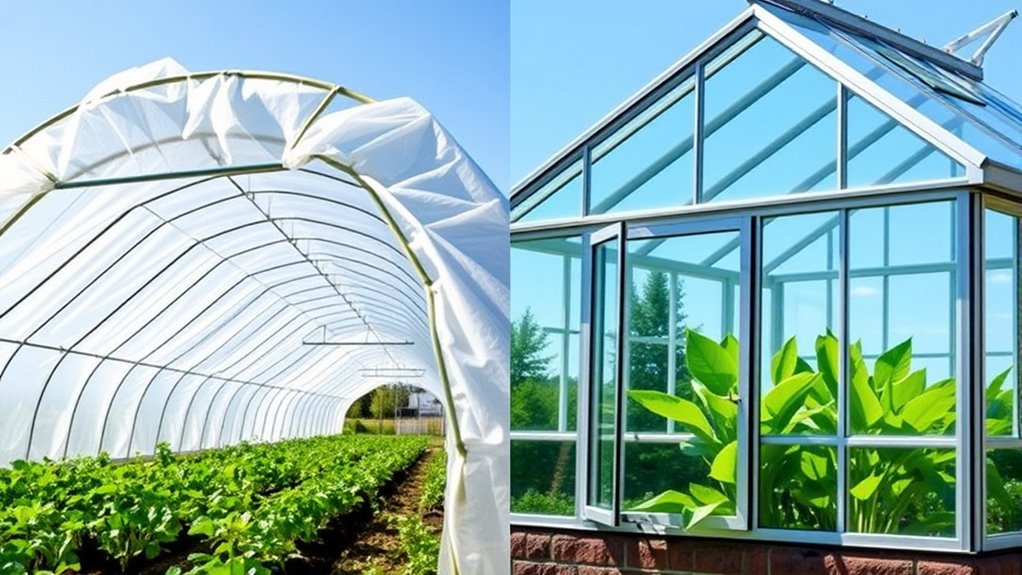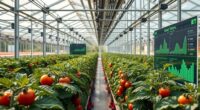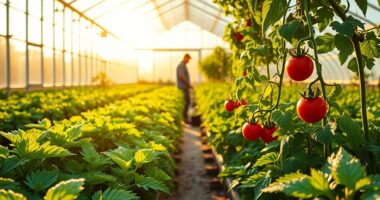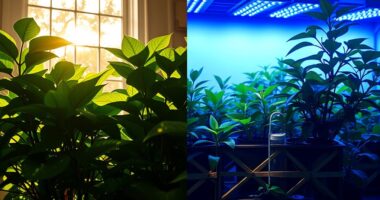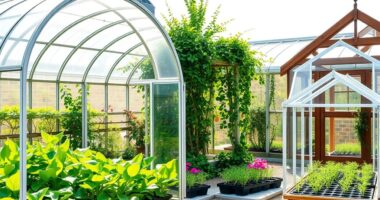High tunnels are simple, affordable structures made with plastic films stretched over metal or wood frames, relying mainly on passive climate control like ventilation and shade. Greenhouses, on the other hand, feature rigid materials like glass or polycarbonate, with advanced systems to regulate temperature and humidity. While high tunnels are great for extending seasons easily and cheaply, greenhouses offer more precise environment control for year-round crops. To learn more about these differences, keep exploring the details.
Key Takeaways
- High tunnels are simple, cost-effective structures with minimal climate control, while greenhouses are more complex with advanced environmental regulation systems.
- Constructed with flexible materials like polyethylene for high tunnels, whereas greenhouses use rigid glass or polycarbonate panels for durability and light transmission.
- High tunnels rely on passive climate methods such as ventilation, whereas greenhouses actively control temperature and humidity with mechanical systems.
- Greenhouses are more expensive upfront but enable year-round cultivation of sensitive crops, unlike high tunnels which are mainly for seasonal extension.
- The choice depends on budget, crop needs, and desired environmental control, with high tunnels offering simplicity and greenhouses providing precision.

Ever wondered how high tunnels and greenhouses differ in their design and function? The main difference lies in their approach to climate control and the construction materials used. High tunnels are generally simple structures with minimal climate regulation, relying heavily on natural elements like sunlight, wind, and temperature fluctuations. They’re usually made with durable, UV-resistant polyethylene or similar plastic films stretched over a sturdy frame of metal or wood. These materials are cost-effective and easy to install, making high tunnels an accessible option for many growers. Because they lack advanced climate control systems, they depend on passive methods such as ventilation and shade cloths to manage temperature and humidity. This simplicity allows for a more natural growing environment, but it also means you have less precise control over conditions compared to greenhouses. Passive climate control methods are a key aspect of high tunnel design that influence their effectiveness. Greenhouses, on the other hand, are designed with a focus on controlling the environment to optimize plant growth year-round. They typically feature rigid construction materials like glass or polycarbonate panels, which provide excellent light transmission and durability. These materials help maintain a stable climate inside, minimizing temperature swings and protecting crops from external weather extremes. Greenhouses often incorporate sophisticated climate control systems, including fans, vents, heating, cooling, and even automated humidity regulation. These systems give you the ability to fine-tune the environment, ensuring consistent conditions regardless of outside weather. Because of their durable construction materials and advanced climate management, greenhouses are more expensive upfront but offer greater flexibility for growing a wider variety of plants, especially those requiring specific temperature or humidity ranges. The choice between a high tunnel and a greenhouse ultimately depends on your goals, budget, and the crops you want to grow. If you’re seeking a low-cost, straightforward solution for season extension or early planting, a high tunnel might be perfect. It allows you to extend your growing season without the need for complex climate control systems. However, if you want maximum control over your growing environment to cultivate sensitive or high-value crops throughout the year, investing in a greenhouse with durable construction materials and advanced climate control options makes more sense. Both structures serve important roles in agriculture and gardening, but understanding their design differences—especially in climate control approaches and construction materials—helps you choose the right setup for your needs.
Frequently Asked Questions
What Are the Initial Costs for High Tunnels Versus Greenhouses?
You’ll find that high tunnels typically cost less upfront than greenhouses, making them a more affordable option for many growers. The cost comparison shows high tunnels usually require lower initial investment, and financing options are often easier to access. Greenhouses, on the other hand, tend to have higher construction costs but may offer more control over environment. Consider your budget and goals to decide which fits best.
How Do Maintenance Requirements Differ Between High Tunnels and Greenhouses?
Ever wondered how maintenance differs? You’ll find that high tunnels need less frequent upkeep, mainly focusing on pest management and simple ventilation strategies to prevent excess humidity. Greenhouses, on the other hand, require more active ventilation, regular cleaning, and system checks for heating and cooling. Do you prefer a low-maintenance setup? Then high tunnels might be your best bet, but if you want precise climate control, greenhouses demand more attention.
Can High Tunnels Be Automated Like Greenhouses?
Yes, you can automate high tunnels using automated environmental controls and remote monitoring systems. While they’re less complex than greenhouses, integrating these technologies allows you to manage temperature, humidity, and ventilation efficiently. You can set up sensors and automated vents to optimize growing conditions, monitor everything remotely, and make adjustments on the go. This automation helps improve crop yields and reduces manual labor, making high tunnels more convenient and productive.
What Is the Lifespan of High Tunnels Compared to Greenhouses?
Think of high tunnels as sturdy, seasonal tents, while greenhouses are like durable, glass castles. You’ll find that high tunnels generally have a shorter lifespan—around 7 to 10 years—due to material wear and tear. Greenhouses, with their better materials, often last 15 to 20 years or more. So, when it comes to durability comparison, greenhouses win in longevity, but high tunnels can still serve you well for several seasons.
Are High Tunnels Suitable for Year-Round Growing?
Yes, high tunnels are suitable for season extension, allowing you to grow crops earlier in spring and later into fall. However, they typically aren’t ideal for year-round growing because they lack the controlled environment greenhouses provide. You can expand crop variety and lengthen your growing season, but for consistent, all-year production, greenhouses with climate control are a better choice.
Conclusion
Think of high tunnels and greenhouses as two different umbrellas for your crops. High tunnels are like a sturdy raincoat—simple, cost-effective, and perfect for protecting plants from the elements. Greenhouses, on the other hand, are more like a transparent dome—offering a controlled environment for year-round growth. Choosing between them depends on your needs, but both are essential tools to nurture your garden’s potential, turning your outdoor space into a thriving oasis.
